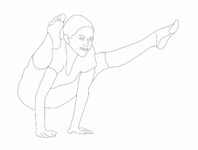What are the 8 limbs of Yoga (Ashtanga yoga)
Maharishi Patanjali advocated the eight limbs of Yoga, also known as Ashtanga Yoga, in his Yoga Sutra. The Yoga Sutra of Patanjali is divided into four chapters or pada. The first chapter deals with Samadhi, the second with the Sadhana to achieve Yoga, the third enumerates the power (Vibhuti), and the fourth deals with absolution (Kaivalya). Ashtanga Yoga of Patanjali can eliminate impurities and enhance knowledge and wisdom. The eight limbs of yoga-Ashtanga yoga are:
Eight Limbs of Yoga-Ashtanga Yoga
- Yama (Restraints)
- Niyama (Observances)
- Asana (Posture)
- Pranayama (Expansion of Breath)
- Pratyahara (Withdrawal of Senses)
- Dharana (Concentration)
- Dhyana(Meditation)
- Samadhi (TranscendentalState)

Ashtanga Yoga Yama (Restraints)
The first limb of yoga is Yama (ethical disciplines), further divided into five components. These five aspects of Yama are the basic tenets of morality for society and the individual, which, if not obeyed, bring chaos, violence, untruth, stealing, dissipation, and covetousness. The five commandants of Yama are:
- Ahimsa (Non-violence): One should not harm living creatures.
- Satya (Truthfulness): One should not lie and refrain from speaking a truth that may hurt others.
- Asteya (Non-stealing): It means to extend that one should not even desire something that is not one’s own.
- Brahmacharya (Celibacy): The behaviour conducive to reaching the spiritual Sadhana’s highest goal.
- Aparigraha (Non-possessiveness): One should avoid collecting things one does not need.
Ashtanga Yoga Niyama (Observances)
Niyama revolves around individual discipline. The five niyama enumerated by Patanjali are:
- Saucha (purity)
- Santosh (contentment)
- Tapas (ardour or austerity)
- Svadhyaya (study of the self)
- Isvara Parnidhana (dedication to the lord)
Ashtanga Yoga Asana
Asana is the third component of the eight limbs of Yoga mentioned in the Patanjali Yoga Sutra. It brings steadiness, lightness, and health to body and mind.
- Asana is confirmed to be steadiness (sthira ) and equally pleasant and comfortable ( sukham). Stability and comfort are the main characteristics of Asana.
- Prayatnasaithilya (relaxation of effort) and Anantasamapatti (merger of mind with infinite) are also characteristics of Asana.
- It implies that the practice of asanas will help the practitioner to endure the dualities and opposites in life, viz. heat–cold, raga-visa, pain-pleasure, etc.
Ashtanga Yoga Pranayama (Expansion of Breath)
Pranayama is the fourth step of Ashtanga Yoga mentioned in Patanjala Yoga Sutra. Prana means breath, respiration, life, vitality, energy, or strength. Ayama represents length expansion.
- Pranayama thus means expansion of breath and its control. These are the functions of breathing: inhalation or inspiration, exhalation or expiration, and retention or holding the breath (a state where there is no inhalation and exhalation).
- Regular practice of Pranayama improves attention, soothes the nervous system, and reduces cravings. As desires and passions diminish, the mind is set free and becomes a fit vehicle for concentration.
Ashtanga Yoga Pratyahara (Withdrawal of senses)
Pratyahara is the fifth component of the eight limbs of Yoga mentioned in the Patanjali Yoga Sutra. It brings control over the senses by withdrawing them from their respective objects.
Types of Pratyahara
- Indriya-Pratyahara – control of the senses;
- Prana- Pratyahara – control of Prana;
- Karma-Pratyahara – control of action; and
- Mano-Pratyahara -withdrawal of the mind from the senses. Each has its unique methods.
Ashtanga Yoga Dharana (Concentration)
Dharana is the sixth component of Ashtanga Yoga outlined in the Patanjala Yoga Sutra.
- It is the confinement of the mind to one point.
- Here, the practitioner concentrates his mind on the internal objects.
- It is the primary stage of Dhyana (meditation).
Ashtanga Yoga Dhyana (Meditation)
Dhyana is the seventh step of Ashtanga Yoga mentioned in Patanjala Yoga Sutra.
- It is an effortless concentration on the defined objects.
- It is the primary stage of Samadhi.
- Dhyana happens naturally when all the distractions do not arise.
Ashtanga Yoga Samadhi (Transcendental State)
Samadhi is the end of a practitioner’s quest. His body and senses still seemed to be asleep. However, his faculties are alert, and the person in this state is fully conscious and alert. It is the eighth component of Ashtanga Yoga outlined in the Patanjala Yoga Sutra.
- It is the trance-conscious state wherein Yogi remains unmoved by physical and mental afflictions.
- In other words, a state of intense concentration achieved through meditation.
- It is the final state of Yoga and has been described variously as a state of uninterrupted joy, peace, absolute consciousness, and self-realisation.






